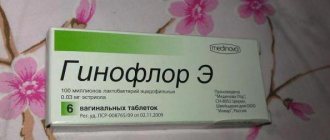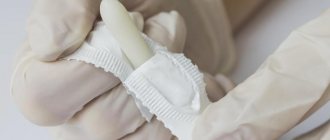Pharmacological action of Gynoflora
Gynoflor contains lyophilisate of Lactobacillus acidophilus, and Gynoflor E additionally includes estriol. The excipients of the drug are microcrystalline cellulose, lactose monohydrate, sodium starch glycolate, anhydrous dibasic sodium phosphate, lactic acid, and magnesium stearate.
Lactobacillus acidophilus in Gynoflora E is a non-pathogenic bacteria that is responsible for the formation of healthy vaginal microflora. They perform a protective function by creating the required pH level of the internal environment, which is not suitable for the reproduction and development of various harmful pathogenic microorganisms. Lactobacillus acidophilus also promotes the fermentation of glycogen in the vaginal epithelium to form lactic acid. As a result, the acidity level in the vagina is stably maintained at 4-4.5. At a pH level that is optimal for the life of lactobacilli acidophilus, the development of pathogenic microorganisms is simply impossible.
All bacteria that are part of the drug Gynoflor, in the process of their vital activity, produce the necessary bacteriocins and hydrogen peroxide, which contribute to the provision of a bactericidal effect against pathogenic microflora.
Estriol, which is part of Gynoflor E, is a synthetic compound that is similar in its actions to endogenous hormones in a woman’s body, which are produced by the ovaries. Estriol does not affect the endometrium, but only affects the vaginal mucosa. Gynoflor stimulates the growth and reproduction of cells in the epithelium of the vaginal mucosa, due to which the condition of the vaginal epithelium improves.
Gynoflor, thanks to the entry of exogenous estriol and Lactobacillus acidophilus bacteria into the vagina, normalizes the state of the vaginal microflora, significantly reduces the risk of developing infections, and also improves the general condition of the mucous membrane.
According to the instructions, Gynoflor E acts only locally, without having a systemic effect.
Gynoflor E
Gynoflor E is a drug with a “female face”: it regulates the balance of vaginal microflora, which is especially important after antibiotic or chemotherapy. The drug is also used for estrogen-dependent vaginitis and bacterial vaginosis. Gynoflor E is a combination of lactobacilli Lactobacillus acidophilus and estriol, while both of these substances participate in maintaining the balance between normal and pathogenic (opportunistic) vaginal microflora.
Lactobacilli are a permanent inhabitant of the vagina of healthy representatives of the fair half of humanity. These gram-positive anaerobes are a kind of “gendarmes” of the vagina, controlling the spread of pathogenic and conditionally pathogenic microorganisms and preventing them from assimilating in the vaginal biocenosis. Estriol is a short-lived estrogen that has a protective and trophic (nutrition-regulating) effect on the vaginal epithelium and does not have a systemic effect on the female body as a whole. The multiplying mature vaginal epithelium accumulates glycogen, a nutrient and energy substrate for lactobacilli. These, in turn, produce lactic acid, which provides an acidic environment in the vagina, which is categorically rejected by pathogenic microorganisms. Another weapon of lactobacilli against pathogenic and conditionally pathogenic objects of the microcosm is the hydrogen peroxide and bacteriocins they produce.
Fluctuations in the balance of vaginal microflora can occur for a number of reasons: the use of antibiotics and other antibacterial drugs, vaginal infections, neglect of hygiene rules.
In such circumstances, the population of lactobacilli may be significantly reduced. Intravaginal administration of gynoflora E has a positive effect on the vaginal epithelium and restores the balance of bacterial microflora. Lactose, present in the preparation as an excipient, turns out to be not a passive observer, but the most active participant in the events: it is used by lactobacilli to produce lactic acid. Gynoflor E can be very useful in the postmenopausal period, when thinning of the vaginal epithelium associated with hormonal disorders and a “bouquet” of unpleasant symptoms (burning, itching, vaginal dryness, discomfort during sexual intercourse) can significantly reduce a woman’s quality of life. The drug tidies up the “worn out” vaginal and urethral epithelium, reducing the risk of dystrophic inflammatory episodes. Laboratory studies have shown that lactobacilli reduce pH to the required level within just a few hours, and estriol, with a therapeutic course of 6-12 days, fully realizes its proliferative trophic effect on the vaginal epithelium.
Gynoflor E is available in the form of vaginal tablets, inserted into the deep “destination” in the supine position. The optimal and most comfortable time of administration is before going to bed.
Indications for use Gynoflora
According to the instructions, Gynoflor is indicated for use to restore vaginal microflora after local antibacterial or systemic therapy with chemotherapy and antimicrobial drugs.
Gynoflor suppositories are recommended for use during menopause and postmenopause, in cases of epithelial disorders and atrophic vaginitis.
The drug should be taken when unpleasant discharge or candidiasis of varying degrees of severity appears. Gynoflor is also recommended for the prevention of vaginitis.
Methods of use of Gynoflor and dosage
According to the instructions, Gynoflor must be inserted deep into the vagina, after moistening the tablet with water. Therapy with Gynoflor suppositories should begin a few days after the end of the menstrual cycle. It is recommended to use the drug in the evening before bedtime.
For infections and vaginal discharge, 2 Gynoflor tablets should be administered per day (morning and evening). The course of treatment is 10 days.
During menopause and postmenopause, you need to use 1 suppository per day. The course of therapy is 10 days.
During therapy with Gynoflor, you should abstain from sexual intercourse or use barrier methods of contraception.
Gynoflor E instructions for use
Release form Vaginal tablets. Pack of 6 pcs.
Pharmacotherapeutic group Estrogen + eubiotic
ATX code :G02CX
Pharmacological properties Pharmacodynamics The active substances included in the drug GynoflorE, estriol and lactobacilli acidophilus, are involved in the physiological mechanism of maintaining normal vaginal biocenosis. Lactobacillus acidophilus is one of the dominant microorganisms in the vagina of a healthy woman, which has antagonistic activity against pathogenic and opportunistic microorganisms. Estriol is a female sex hormone, a short-acting estrogen. It has a protective trophic effect on the vaginal epithelium and has no systemic effect on the woman’s body. The proliferating mature vaginal epithelium accumulates glycogen, which is necessary for the functioning of lactobacilli, which, in turn, produce lactic acid, maintaining the acidic environment of the vagina (pH 3.8-4.5), which creates unfavorable conditions for the colonization and development of pathogenic microorganisms. In addition to lactic acid, lactobacilli acidophilus produce hydrogen peroxide and bacteriocins, which also inhibit the development of pathogenic and opportunistic microorganisms. Changes in the physiological flora of the vagina occur due to various factors: local or systemic use of antibacterial drugs, incl. due to vaginal infections, systemic diseases, poor hygiene. In these cases, the number of lactobacilli can be significantly reduced. Intravaginal use of the drug Gynoflor E improves the condition of the vaginal epithelium and restores its normal flora. Lactose, which is found in vaginal tablets as a filler, can also be fermented by lactobacilli into lactic acid. The vaginal epithelium becomes thinner and can be damaged due to hormonal disorders, and therefore the drug Gynoflor E can be used in postmenopause to alleviate its local symptoms (itching, burning, vaginal dryness, pain during sexual intercourse), helping to normalize the condition of the vaginal and urethral epithelium, reducing the frequency of dystrophic inflammatory conditions. In vitro it has been shown that lactobacilli acidophilus lead to the necessary decrease in pH within a few hours. Estriol, with a treatment duration of 6-12 days, provides a proliferative trophic effect on the vaginal epithelium.
Pharmacokinetics When the drug is administered into the vagina, lyophilized bacteria and estriol are released. The absorption of estriol from the drug Gynoflor E has been studied in postmenopausal women. After repeated use of the drug, the concentration of estriol in plasma corresponds to the concentration of endogenous unbound estriol. After the 12th day of using vaginal tablets during treatment with Gynoflor E (1 time per day), the maximum concentration of unbound estriol in the blood plasma does not differ from the initial one, which indicates the absence of systemic absorption. The use of the drug does not affect the concentration in the blood plasma of sex hormones present in a woman’s body - estrone and estradiol, since estriol is the end product of their metabolism.
Indications Restoration of normal vaginal microflora after local and/or systemic use of antibiotics or antimicrobial drugs (including vaginal infections: bacterial vaginosis, nonspecific vulvovaginitis; urogenital infections and sexually transmitted diseases). Estrogen-dependent atrophic vaginitis in postmenopause, including in combination with hormone replacement therapy (HRT).
Contraindications: hypersensitivity to the drug or its components; malignant estrogen-dependent neoplasms, incl. mammary glands, uterus, ovaries or vagina (diagnosed, in history, and if they are suspected); endometriosis (suspected or diagnosed); bleeding from the vagina of unknown etiology; use in girls before sexual activity; untreated endometrial hyperplasia.
Use during pregnancy and breastfeeding Use in the first trimester of pregnancy is undesirable. It is possible to use the drug Gynoflor E in the II-III trimesters of pregnancy and during breastfeeding. No undesirable effects of lactobacilli and estriol on pregnancy and the condition of the fetus/newborn were detected. However, long-term clinical studies on the effects of estriol on the fetus have not been conducted.
Special instructions The drug Gynoflor E contains components that may not completely dissolve; residues of the vaginal tablet can sometimes be found on underwear. This does not affect the effectiveness of the drug. In isolated cases, with vaginal dryness, the vaginal tablet may not dissolve. To prevent such cases, the tablet can be moistened with a small amount of plain water before administration - this will help it dissolve more quickly. Patients are advised to use pads.
Composition Composition for 1 vaginal tablet: Active substances: Lactobacillus acidophilus (lyophilisate) 50.00 mg (at least 100 million viable bacteria), estriol 0.03 mg; Excipients: lactose monohydrate 625.6 mg, microcrystalline cellulose 183.7 mg, magnesium stearate 6.67 mg, sodium carboxymethyl starch 30 mg, sodium dihydrogen phosphate 4 mg.
Description The tablets are oval, biconvex from white to light beige in color with inclusions.
Method of administration and dosage Vaginal tablets should be inserted deep into the vagina in the evening before bed, preferably while lying on your back, with your knees slightly bent. To restore normal vaginal microflora after local and/or systemic use of antibiotics or other antimicrobial drugs (including for vaginal infections: bacterial vaginosis, nonspecific vulvovaginitis, urogenital infections and sexually transmitted diseases): 1-2 vaginal tablets daily for 6-12 days. When treating estrogen-dependent atrophic vaginitis in postmenopause: 1 vaginal tablet daily for 6-12 days, then the maintenance dose is 1 vaginal tablet 1-2 times a week.
Side effects Possible burning sensation (heat) in the vagina, rarely redness and itching of the vulva and vagina.
Drug interactions Lactobacillus acidophilus is sensitive to numerous antibacterial drugs (local or systemic use). Concomitant treatment with such drugs may lead to a decrease in the effectiveness of GynoflorE. Therefore, its simultaneous use with antibacterial drugs is not recommended. It is not recommended to use the drug Gynoflor E together with spermicidal agents.
Overdose An overdose of the drug has not been observed.
Storage conditions Store at a temperature of 2 to 8 °C. Do not freeze! Keep out of the reach of children.
Shelf life: 3 years. Do not use after expiration date.









